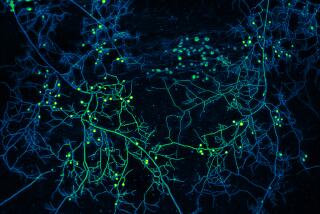Use of Fungi for Plant Cultivation Mushrooms
- Share via
GRANTS PASS, Ore. — Mike Amaranthus opened the glass door of a refrigerator case and peeled back the top of a plastic container to reveal a musty brown powder.
“Two tablespoons of this powder contains more spores than there are people on earth,” he said. “You can imagine what you can do with 50 pounds.”
Amaranthus and a handful of other entrepreneurs are selling the spores of mushrooms, puffballs and truffles as an organic and highly successful alternative to chemical fertilizers and pesticides.
To make his point, Amaranthus offers test plants--roses, maple trees and marigolds--grown with and without the fungi. Those inoculated with spores are bigger, leafier, and have more blooms.
“Most people relate to fungi moldy bread and itchy toes, but 90% of the world’s plants form a beneficial relationship to fungi that we call the mycorrhizae,” said Amaranthus, a soil scientist.
Hence the name of his company, Mycorrhizal Applications Inc.
The relationship can be traced to the earliest fossils of land plants, leading scientists like Amaranthus to theorize that fungi helped ancient aquatic plants make the jump to the hostile environment of dry land.
The fungi attach to the roots of the plant and help it take in moisture and nutrients through a network of tiny filaments called hyphae that spread through the soil, increasing the root mass 10 to 10,000 times. The plants feed the fungi in return.
Amaranthus first ran across mycorrhizae in 1976, when he started working for the Siskiyou National Forest. Many foresters still regarded the white and yellow strands they saw on tree roots as pathogens attacking the trees, but he found that they were beneficial.
Through his doctoral work in forest ecology at Oregon State University and later work for the U.S. Forest Service’s Pacific Northwest Research Station, Amaranthus helped unravel the secret life of trees and mycorrhizal fungi.
In 1997 he left the woods to bring mycorrhizae to the marketplace. He ran through his retirement savings getting started, but is now making a profit and employing five people full time.
The spores come from mushrooms, puffballs and truffles harvested from the wild as well as cultivated around the world. Amaranthus won’t divulge financial information but says last year Mycorrhizal Applications sold enough spores to inoculate 200 million plants. They are gearing up to produce enough for 1 billion plants.
Amaranthus’ business is small. Plant Health Care Inc., in Pittsburgh, Pa., claims the title of industry leader, with annual revenue of $100 million four years after start-up.
The company supplies beneficial bacteria as well as mycorrhizal spores for arborists, nurseries, landscapers, turf farms, golf courses and fruit and vegetable growers.
“We think that because of regulation of soil fumigants as well as increasing regulation of certain classes of chemical pesticide, more and more growers are becoming open to and interested in the below-ground ecology of the plant,” said president Wayne Wall.
Complaints against the soil fumigant methyl bromide, used to control things like root-eating nematodes, are growing because of fears over ozone depletion and health risks. The Environmental Protection Agency recently moved to ban methyl parathion, which is commonly sprayed on apples, because of child health concerns.
Research has shown that mycorrhizals help plants absorb essential micronutrients such as calcium, and can even help control pests like root-feeding nematodes.
Mount Angel hops grower John Annen tried some spores to see if they would help him root a difficult strain of hops in the greenhouse. He began using them on everything after his success rate nearly doubled.
He said the hops treated with mycorrhizals have bigger root systems, need less fertilizer and resist insects better, allowing him to skip one application of insecticide.
“When I first heard about it I was very skeptical,” he said. “I checked it out with a few people at the college, field men, whatnot, and they told me this was nothing new, it had been studied for years, but nobody went anywhere with it. What this stuff can do is absolutely amazing.”
Plants link up with specific fungi, so Mycorrhizal Applications makes custom mixes for commercial clients in liquid, powder or gel. The spores can be mixed with potting soil, dripped on through irrigation, sprayed on by crop duster or dropped into the soil at planting time.
The aboveground results produced by fungi could be achieved applying fertilizer every two weeks, but 70% to 90% of nitrogen applied in nurseries is not absorbed by the plants and ends up getting washed into rivers, where it is a pollutant, Amaranthus said.
One inoculation of fungi lasts all year, costs pennies a plant and produces a bigger root system that is also resistant to disease.
“Nature has provided the template,” Amaranthus said. “The problem is education.”






